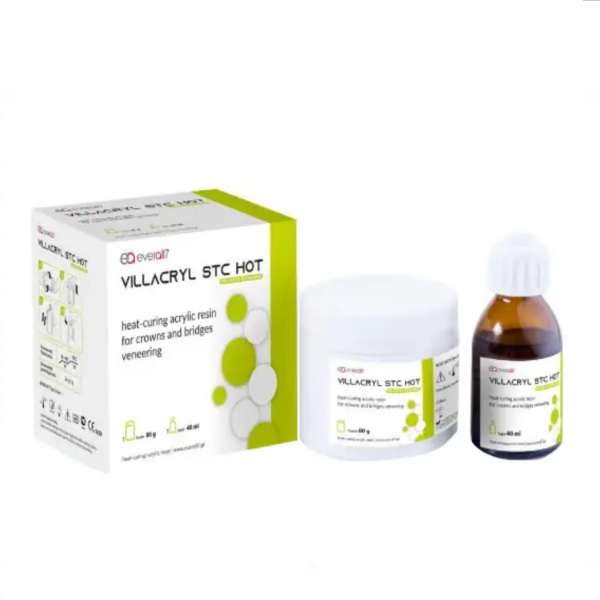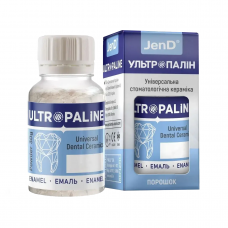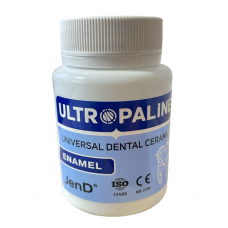Villacryl STC Hot - Acrylic material for veneering crowns and bridges.
Product characteristics: Acrylic matepial intended for facing crowns and bridges. Classification according to ISO 10477: Type II.
Purpose: crowns and bridges lined with acrylic plastic
Color: There are the following colors: A-1; A-2; A-3; A-3.5; A-4; B-1; B-2; WITH
Preliminary preparation:
The metal frame of the crown or bridge is made using the traditional method. Chewing surfaces should remain metal. The part intended for facing must have retention elements (balls). After polishing the structure, the fragments intended for cladding must be sandblasted (aluminum oxide) with a granulation of 250 microns under a pressure of 4-6 bar and masked with appropriate preparations that mask and improve acrylate-metal adhesion (Villacryl Opaker is recommended). We place the prepared structure on the working model and use modeling wax to model the shape of future facings. Replacing wax with acrylic should be done using the traditional method. In the lower part of the polymerization cuvette intended for the manufacture of crowns and bridges, we immerse the metal part of the structure in second-class plaster (Stodent II is recommended), so that the front part remains open. After hardening, the gypsum surface must be insulated with a gypsum-gypsum insulator. Then we string the second part of the cistern, the so-called counter-form, and fill it with second-class plaster. After 20 minutes, when the gypsum has reached sufficient hardness, the cuvette should be opened, the wax should be evaporated with hot water, and the form should be insulated with a gypsum-acrylic insulator (for example, Z-Sol). After cooling the cuvette to room temperature approx. 23 °С you can start applying the acrylic test.
Dosage and mixing:
Pour the appropriate amount of monomer into a glass vessel and add powder (dentin) of the appropriate color to saturation and mix thoroughly. After 2 minutes, pour the appropriate amount of monomer into the second vessel and add enamel powder and mix thoroughly. Cover the vessels tightly. After some time, check the ripening of the dough.
Packaging:
After 8-10 min. from the moment of mixing the powder with the liquid, the dough is suitable for placement in a plaster mold. Carefully knead the dentinal part through the extrusion with clean and dry hands, place it in a mold and cover it with polyethylene foil, collect the cuvette and place it under the press. Press carefully until the edges of the cuvette meet completely. Remove the cuvette from under the press, remove the foil, cut a part of the dentin diagonally in the direction of the cutting edge with a sharp tool. In the place of the cut acrylic, apply the previously prepared enamel, re-lay the foil and press the cuvette to a pressure of 3000 kg. Open the cuvette and check the correct transition of the dentine part to the enamel. If everything is in order, remove the excess pressed from the sides of the acrylic, assemble the cuvette without foil and re-press to a pressure of 3000 kg. After 10 minutes, remove the cuvette from the press and twist it in the polymerization frame.
Polymerization:
Place the cuvette with the frame in water at a temperature of 80-90°C and boil for 30 minutes.
Processing:
After cooling to room temperature, open the cuvette and release the work from the plaster. Processing and polishing by standard method.
Precautions:
Information for technicians
- Highly flammable liquid (contains methyl methacrylate); flash point +10°C. Keep away from sources of fire and radiation.
- Do not eat or smoke while working with the drug.
- Possibility of eye, respiratory and skin irritation.
- In case of contact of the drug with eyes, wash them with water and contact a doctor.
- Avoid inhalation of monomer vapor.
- Work in a well-ventilated area.
- The place of skin contact with the drug should be thoroughly washed with soap and water.
- In case of accidental ingestion, call a doctor.
- Harmful to the environment. Do not pour the monomer down the drain. Information for dentists
- The possibility of transmission of infection. Each crown or bridge must be rinsed and disinfected before placing in the mouth.
- Popular and widely available toothpastes can be used for the hygiene of crowns and bridges.
Storage conditions:
- The liquid is sensitive to temperature and UV radiation
- Store in the original packaging, in a dark and well-ventilated room at a temperature of 5-28°C, in a place inaccessible to children.
- Do not use the drug after the expiration date.
- Unused material and packaging are dangerous for the environment. Dispose of in accordance with applicable laws.
Packaging: 80 g of powder, 40 ml of liquid, instructions for use.
WARNING!
Material for use exclusively in dental laboratories.
Written and verbal instructions and information transmitted during the demonstration conducted by the manufacturer derive from this level of dental equipment and technology. They must receive binding information. Information received from other persons (due to different levels of their authority) does not exempt the consumer from personally checking whether the drug is suitable for a certain purpose. Since the use of the drug takes place without the possibility of control by the manufacturer, this limits the manufacturer's responsibility to the value of the delivered product.
There are no reviews for this product, be the first to leave your review.

No questions about this product, be the first and ask your question.



